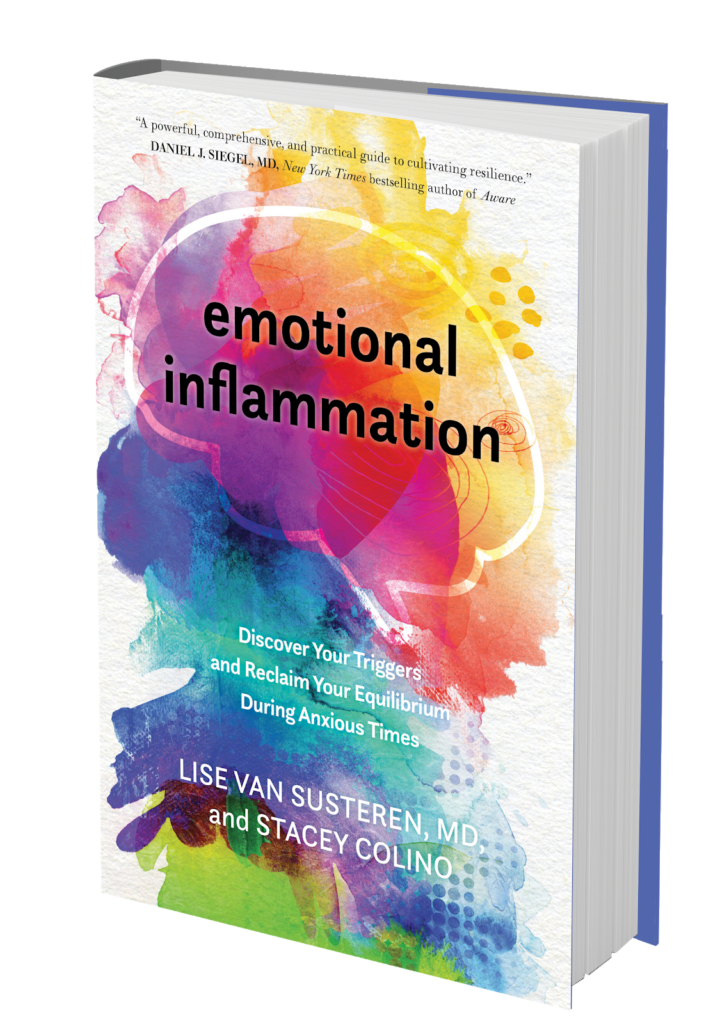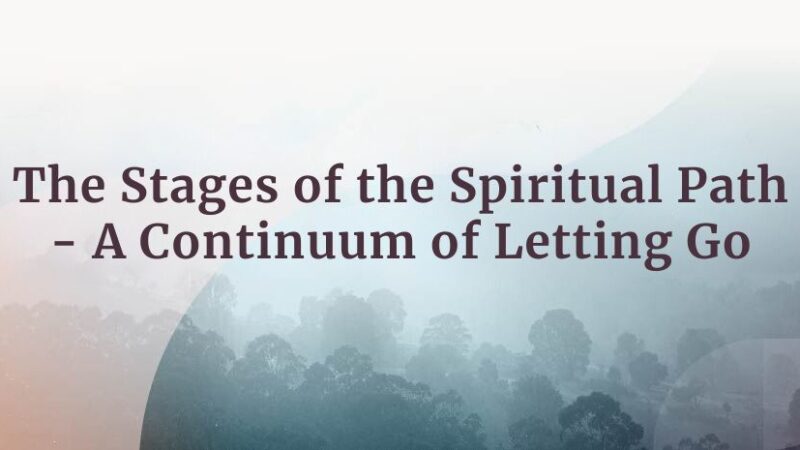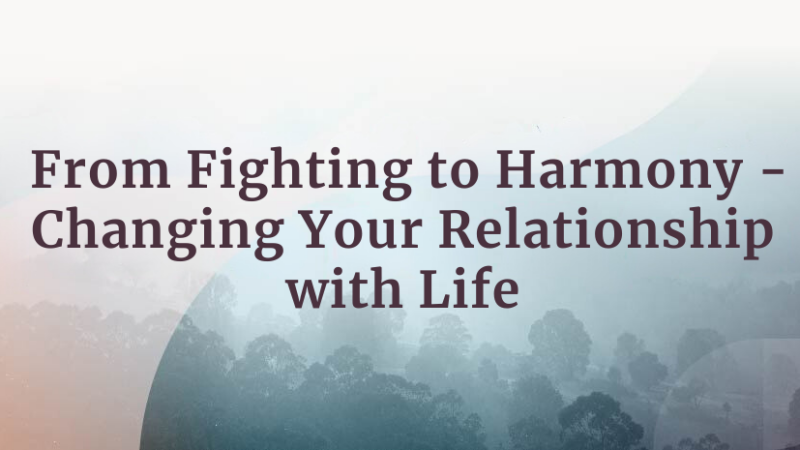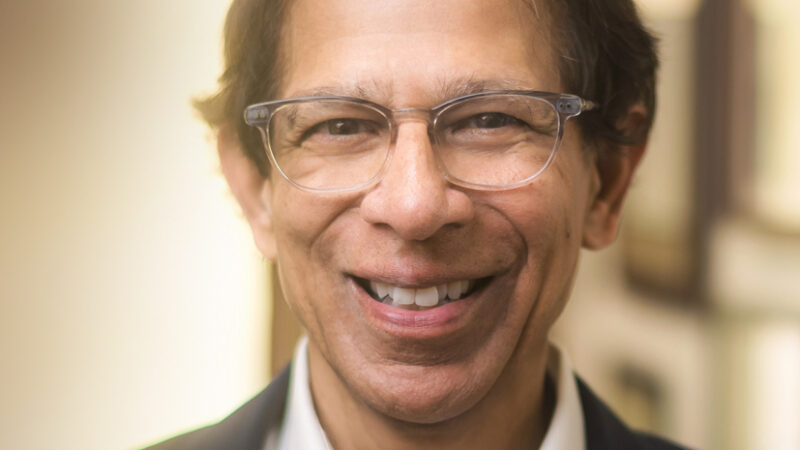-
E90: How to Stop Minding and Start Living
Michael Singer — June 29, 2025
“Do you mind?” We “mind” everything, from traffic to childhood memories, and this habitual...
-
Cyndi Dale: Becoming Your Own Best Ancestor
Cyndi Dale — July 1, 2025
On the surface, it appears as though the lives we live proceed forward moment by moment in a...
-
Honey Tasting Meditation: Build Your Relationship with Sweetness
There is a saying that goes “hurt people hurt people.” I believe this to be true. We have been...
Written by:
Amy Burtaine, Michelle Cassandra Johnson
-
Many Voices, One Journey
The Sounds True Blog
Insights, reflections, and practices from Sounds True teachers, authors, staff, and more. Have a look—to find some inspiration and wisdom for uplifting your day.
Standing Together, and Stepping Up
Written By:
Tami Simon -
The Michael Singer Podcast
Your Highest Intention: Self-Realization
Michael Singer discusses intention—"perhaps the deepest thing we can talk about"—and the path to self-realization.
This Week:
E90: How to Stop Minding and Start Living -
Many Voices, One Journey
The Sounds True Blog
Insights, reflections, and practices from Sounds True teachers, authors, staff, and more. Have a look—to find some inspiration and wisdom for uplifting your day.
Take Your Inner Child on Playdates
Written By:
Megan Sherer
600 Podcasts and Counting...
Subscribe to Insights at the Edge to hear all of Tami's interviews (transcripts available, too!), featuring Eckhart Tolle, Caroline Myss, Tara Brach, Jack Kornfield, Adyashanti, and many more.
Most Recent
S2 E2: The Stages of the Spiritual Path – A Cont...
How do you know when you’re actually walking the path or when you’re just strengthening your ego? Here, Michael considers the gateways to and pitfalls of spiritual work.
For more information, go to michaelsingerpodcast.com.
© Sounds True Inc. Episodes: © 2024 Michael A. Singer. All Rights Reserved.
Is There a Holy Grail of Healing?
Lissa Rankin, MD, is a New York Times bestselling author of multiple books including Mind Over Medicine, a physician, speaker, founder of the Whole Health Medicine Institute and the nonprofit Heal At Last, and mystic. Lissa has starred in two national public television specials, her TEDx Talks have been viewed over 4 million times, and she leads workshops both online and at retreat centers like Esalen, 1440 Multiversity, Omega, and Kripalu.
In this podcast, Dr. Rankin speaks with Sounds True founder, Tami Simon, about her new book, Sacred Medicine: A Doctor’s Quest to Unravel the Mysteries of Healing. Their conversation explores: the placebo effect and the mega-placebo effect; the scientific method and some assumptions we should question; the relationship between trauma, the nervous system, and healing; connectivity and co-regulation; developmental trauma, or what Mark Epstein calls “the trauma of everyday life”; the concept of spiritual bypassing; chronic inflammation as a root cause of many diseases; the paradoxes of healing; our four “intelligences”—mental, somatic, intuitive, and emotional—and what to do when they “disagree”; Internal Family Systems (IFS) therapy and working with the polarized parts within ourselves; healing the collective; and more.
S2 E1: From Fighting to Harmony – Changing Your ...
The world’s great wisdom traditions all speak on the value of surrender. In this episode, Michael discusses what it takes to grow beyond spiritual resistance.
For more information, go to michaelsingerpodcast.com.
© Sounds True Inc. Episodes: © 2024 Michael A. Singer. All Rights Reserved.
Customer Favorites
Coming Awake to Your Projections and Loving Yourself

When I was in my twenties, I noticed something odd.
Hanging out with my more conservative friends often meant that I’d be called out for my hippie tendencies. What was more, I found myself being swept along by the current of their opinion; I felt like a hippie around them. Because of that, I wound up falling into more “hippie-like” behavior.
With my more bohemian friends, though, I was referred to as The Conservative. And with them, I felt and acted more conventional. It was simply easy to fulfill their expectations. “What gives?” I thought. “I’ve been the same person this whole time!”
I wanted so much for everyone to just see me. What a painful and lonely feeling.
I wanted so much for everyone to just see me.
This phenomenon—being mistakenly and reductively typecast—wasn’t just happening with my friends. It was happening with my husband. It was happening with my family members. And, it was happening within my own mind.
This kind of thing can make knowing and loving yourself a bit confusing.
WHAT IS PROJECTION?
Over time, I’ve come to realize that humans are constantly projecting. People I don’t know very well, my closest friends, my family members, co-workers… everybody does it. This can include assumptions, expectations, stereotypes, attributes, simplifications, unrealistic positives and negatives, and so on.
Have you ever noticed something like that happening to you?
Perhaps, as a woman, you’ve been treated like you’re not as smart or capable as you actually are. Maybe you’ve been feared as a man, seen as more aggressive than you actually are.
Perhaps someone treated you as a doormat when you’re not. Maybe someone thought you had more patience or expertise than you do. It’s possible and common to experience different—even opposite—projections coming from different people.
I’m uncomfortable with negative projections, but I’m uncomfortable with the positive ones, too. Because neither are the real me. At least, not what I believe to be the real me. And they certainly don’t include the whole picture.
Another thing: I’ve noticed that when someone makes a strong projection on me, no matter what I do, I just seem to confirm what they’re already projecting.
Through it all, I still just want to be seen.
By now I’m thinking of that famous saying, “Everyone’s crazy but thee and me. And sometimes I wonder about thee!” We’re thinking it’s everyone else who’s projecting like mad. Um, how about you and me?
Yuck. Is there a way out of this?
COMING AWAKE IN WESTERN THOUGHT

Let’s start with a look at how some in the West work with projection.
Psychoanalyst and spiritual explorer Carl Jung (1875-1961) had some very helpful things to say on this. He explored the idea that we all have some version of all characteristics and characters—both positive and negative—floating around inside of us, somewhere. And, for one reason or another, there are some we aren’t able to see in ourselves.
As our personalities form, we take some of those characters and consciously identify with them: I’m a savior/warrior. I’m the class cut-up. I’m a geek. I’m a bad boy. I’m the nurturing father. I’m the dependable one.
The qualities we’ve set out in the sunshine, for all others to see, get the chance to develop nicely. How lovely for them. But what about all of the other qualities and characters that we aren’t claiming with our conscious mind?
They’re underground—in the basement.
The ones we really don’t want to claim, we do our best to keep in that dank, dark basement.
Instead of getting a chance to develop and mature, our unclaimed characteristics just kind of… fester. They get frustrated and funky. And trust me—they don’t stay obediently in the basement forever.
COMMUNICATING WITH OUR UNCONSCIOUS
We’re the last to be conscious of our own unconscious. There’s a bumper sticker for you!
Jung popularized the concepts of dream interpretation and something called active imagination to try to coax our unclaimed natures into our conscious mind.
I was lucky enough to go to a Jungian Analyst who, borrowing from Fritz Perls’ Gestalt work, had me sit in another chair and become some disowned part of myself. I then went back and forth between the two chairs, having a conversation.
I found this approach extremely clarifying and helpful. I immediately tried it out with a client who had a terrible procrastination problem.
I had her go back and forth between two chairs: one was like her older sister, whom she saw as overbearing, and the other was like her more childish self. The two had a rousing debate over what she should do with her weekend—party or study. Each of them passionately insisted they had her best interests at heart. They were both right.
Then, I had her sit in the middle and be the peacemaker. She got her dissonant selves to forge a deal to alternate between partying and studying.
All of this was a revelation to her. She had identified only with the fun-loving gal. Then, in desperate moments, her other side would come out of the basement and become a crazed slavedriver. Through this conversation, she found that she could make a clear plan to have a balanced, happy weekend that didn’t jeopardize either her happiness or her grade point average. And it expanded her identity, her sense of herself. Her view of her older sister changed, too.
COMMUNICATING WITH OUR LOVED ONES
Here’s another idea. It goes something like this: We admit that we’re all projecting on each other all the time, and we’re each the last to know we’re doing it.
Usually, the projectee knows way sooner than the projector. So let’s make a deal: If you gently tell me what you’re perceiving (hopefully with specific examples, because I’ll probably be clueless), I’ll do the same for you.
We both give each other permission to do this. We both learn how to do it with skill and kindness.
Note that this approach works for both parties. The projector can let us know what they’re seeing; the projectee can share what they think the projector might be inaccurately (or incompletely, and certainly unintentionally) projecting onto them. And vice versa.
Imagine if, alongside doing the inner work, we all helped one another, too. We might get better and better at knowing ourselves—both the good and bad—and begin to take back our natures as a simple consequence of self-love and acceptance.
COMING AWAKE IN EASTERN THOUGHT
 The array of Tibetan practices offer a myriad of profound tools. These help us take our characters out of the basement and bring them into their fullest, most highly developed forms.
The array of Tibetan practices offer a myriad of profound tools. These help us take our characters out of the basement and bring them into their fullest, most highly developed forms.
There are, for example, the One Hundred Peaceful and Wrathful Deities, as well as practices involving various enlightened masters. Each is an image of an archetype—a facet or principle of reality. Being principles of reality, these archetypes are all everywhere, including in each of us.
An archetype is like one of those snowflake stencils many of us created as kids by making little cuts in a piece of paper. You spray paint through it and when you take it away, voilá, a snowflake you can make again and again.
Once you use the stencil, you just see the painted snowflake. Jungians like to use the metaphor of a magnet hidden under a piece of paper that has iron filings on it. As you move the hidden magnet, it draws the filings into different shapes. We see only the shapes of the filings, not the magnet.
COMMUNICATING WITH ARCHETYPES: THE GREAT MOTHER
Let’s take the Great Mother archetype.
In Tibetan practice, both men and women practice Green Tara. They invoke that principle from outside, and evoke it from the inside.
Since we have trouble relating to the pure unseen principle/archetype, we use image (a beautiful green lady), archetypal sound (mantra), and even smell (incense).

Image courtesy of Osel Shen Phen Ling: www.fpmt-osel.org.
We all tend to have internal conversations and dramas with people. But in this case, the setup for our connection with Green Tara is perfectly designed to give us a much more profound, powerful, and enlightened experience than, say, imagining calling our earthly mom on the phone.
Though our mom is just a human being, with faults and foibles, Green Tara is the image that naturally evokes the perfect facet of enlightened mind that is the essence of the mother principle.
The classic progression is that we consciously project Tara out from our hearts, where Tibetan Buddhists believe our mind mainly resides. We project her above us, seeing her clearly in our mind’s eye.
We do this by inviting her, welcoming her, asking her to sit, offering her water, flowers. Then we say the mantra associated with her: Om tarey tuttarey turey soha.
Often we then imagine her descending into us, dissolving into us, becoming indistinguishable from us. We emerge as Tara ourselves, grounding ever more strongly in the owning of that pure archetype.
COMMUNICATING WITH ARCHETYPES: HAYAGRIVA
Let’s take Fred, for an imaginary example. He thinks of himself as a Mr. Nice Guy.
This means that when people want to walk all over him, he doesn’t have the wherewithal, in his conscious array of characters, to assert himself. His Tough Guy or Warrior is in the basement. It’s been lurking there all his life, and isn’t very presentable, as a result.
Whenever Fred gets cornered he suddenly bites the person’s head off … then regrets it later, and may not even get what he needs. Martha Beck refers to this as an “exploding doormat.”
Fred might do well to practice Hayagriva, a fierce, enlightened being of a class known as protectors. They can act with great ferocity, but always with wisdom and compassion.

Magdalena Rehova / Alamy Stock Photo
If Fred were to inhabit Hayagriva the way we talked of inhabiting/owning Tara, he would find his way to the pure essence of that murky, funky character who popped out when he exploded. Once he’d spent time owning and inhabiting Hayagriva Fred is much more likely to skillfully, kindly, and firmly ward off people walking all over him.
Whether it’s a peaceful one like Tara or a more wrathful one like Hayagriva, we must fully own the archetype. It has gone from something we can’t see or feel, to a pure presence that we fully identify with.
COMMUNICATING WITH OURSELVES
Over time, as we get used to owning these presences consciously, we have little need to project it onto someone else. And in owning this purer form, we can often bring forth those qualities in everyday life. They’re much more at our fingertips.
In Tibetan Buddhist deity practice, the goal is to take us from our usual, banal and confused state, to dak-nang, or pure vision—seeing things as they really are.
Imagine if everyone did such well-honed practices, on a lot of different deities. I believe we would then be able to take the various characters out of our basements, develop them, and “play” them in various moments in life.
Playing with a full deck, you might say!
A CULTURE COMING AWAKE

Reality is a vast, perfect ocean that loves to create ever-changing waves and play with them. This ocean is bursting, overflowing with love and joy. But most of us waves don’t see it that way.
The essential intent of the Buddha is to use practices to wake ourselves from the dream/trance we find ourselves in. “Buddha” means one who is awake.
We don’t realize that we’re not just a wave, but made of ocean. We are all both wave and ocean.
COMMUNICATING WITH LIKE-MINDED PEOPLE
Imagine if a critical mass of people became fluent in these skills and capacities, bringing us closer together in camaraderie rather than causing us to build walls of protection and projection against each other.
Imagine less of a need to blame others for our own issues. Less excuses to act snotty and selfish and ignorant and even rageful. How different this world would be.
I believe this is something we all must do to solve the problems that now threaten our happiness and our very existence. We must progress from the swarm of projections, both societal and personal, which cause such pain, to really seeing each other.
Then we could all relax our defenses—because those projections feel terrible—and we could work together to solve the dire problems we’re all actually facing together.
Beyond even that, we’d find that human relations can be much simpler than we thought! They can feel deeply connected, warm, and delicious. We can be seen in our full light.
* * *
In our Namchak Learning Circles, we encourage people to awaken to their unconscious selves. We offer a weekend training in working on projections, in which we learn not only about projections but about how to work compassionately and skillfully to talk about them with each other. As you have probably gathered, that last part is important!
ABOUT THE AUTHOR

Lama Tsomo is a spiritual teacher, author and co-founder of the Namchak Foundation and Namchak Retreat Ranch.
Born Linda Pritzker, Lama Tsomo followed a path of spiritual inquiry and study that ultimately led to her ordination as one of the few female American lamas in Tibetan Buddhism.
Today, she works to share the teachings of the Namchak tradition, a branch of Tibetan Buddhism. Utilizing her psychology background, Lama Tsomo works to make it easier for Westerners to bridge contemplative practice and modern life. She is particularly passionate about reaching young people and supporting those working for positive social change.
Fascinated by science from an early age, Lama Tsomo’s teachings often reference the science behind meditation and the proven neurological impact. She holds an M.A. in Counseling Psychology and is the author of Why Is the Dalai Lama Always Smiling? An Introduction and Guide to Tibetan Buddhist Practice and co-author of The Lotus & the Rose: A Conversation Between Tibetan Buddhism & Mystical Christianity.
Dilip Jeste, MD: Wiser, Faster
Dr. Dilip Jeste is a professor of psychiatry and neurosciences and the director of the Center for Healthy Aging at UC San Diego. He’s spent the last 20 years studying aspects of healthy aging and the neurobiological roots of wisdom. With Sounds True, Dr. Jeste has written a new book titled Wiser: The Scientific Roots of Wisdom, Compassion, and What Makes Us Good. In this episode of Insights at the Edge, Tami Simon speaks with Dr. Jeste about wisdom—what it is, how we can cultivate more of it in our own lives, and how we can grow into a wiser society. They explore a new definition of wisdom that incorporates neurobiological and evolutionary components of what makes us wise, as well as the social and cultural ones we might be more familiar with. Dr. Jeste and Tami also discuss the future of wisdom, including the potential of a metaphorical “wisdom pill.” Finally, they speak on the importance of helping our society become wiser, faster.
What Triggers Your Emotional Inflammation?
It’s time to start unraveling the mystery of you by exploring your current state of mind. Think of this as an adventure, a path toward greater self-understanding and self-compassion—and an expanded appreciation of the complexity of you. To get a sense of the modern-world issues that tend to rile or upset you, put on your imaginary miner’s hat and head into the depths of your mind to see what lies below your conscious awareness. (You may want to do this with a trusted friend or partner.)
Consider your true feelings about the following subjects, without letting preconceived ideas about the right or politically correct way to think or feel about these subjects guide you; simply let your real feelings flow out of you in a free-association style.
Have a journal and a piece of paper ready. As you read the following words and phrases, jot down the first three to five words or phrases that come to your mind in response (don’t edit or change what occurs to you instinctively):
- • Climate crises
- • Me Too scandals
- • Human rights abuses (on a grand scale)
- • Political corruption
- • Racial, religious, gender, or political discrimination
- • Environmental threats (toxins in our midst)
- • Volatile financial circumstances
- • Natural disasters (wildfires, floods, storms)
- • International threats
- • Social divisiveness in this country
- • Hate crimes
- • Nuclear weapons threats
- • Gun violence
If other current events are triggering emotional inflammation for you, write them down in your journal or on a piece of paper.
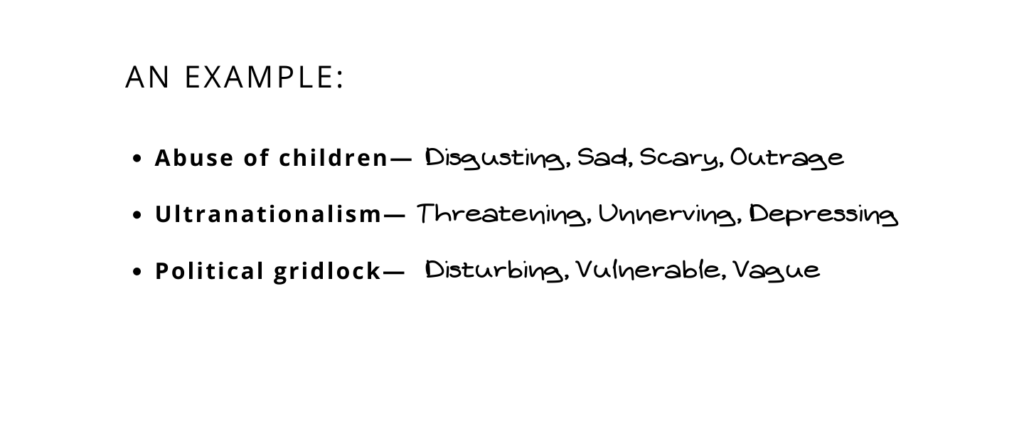
Don’t worry if you feel put on the spot, thought-tied, and unable to come up with the right words to describe how you feel in response to the prompts listed above. Take a deep breath, exhale, and peruse this sample response. Rather than letting this person’s examples sway or influence you, try to use them as inspiration to unlock the floodgates on your true feelings.
Now it’s your turn!
After you’ve completed your list, assign a value to each of these concerns in terms of their potency for you on a scale of 0 to 3 (with 0 being neutral and 3 being intense). Do this quickly so you don’t have too much time to think about it or second-guess your instinctive responses. Once you’ve finished this, place these triggers into a hierarchical list from a potency of 3 to 0, based on how they affect or resonate with you. This will give you a sense of what is likely to get you riled up these days.
If you want to dig a bit deeper, think about the way you responded to the descriptions of certain triggers—that you felt disgusted, violated, sad, and threatened when you thought about Me Too scandals, for example—then consider whether any situations from your past have evoked similar feelings for you. As you may see, emotional injuries or reverberations from the past can make you vulnerable to similar insults and assaults in the present. It’s almost as if you have an emotional ember lying beneath your consciousness, and it’s predisposed to flaring up from time to time. If you hear a single piece of distressing news and find yourself reacting surprisingly strongly to it, think about what else may be crashing around you or whether the news has somehow opened Pandora’s box and exposed you to a deep abyss of other fears and worries. Or it may be that a more superficial emotional injury is on the way to healing but then the scab gets ripped off and the wound bleeds again when another upsetting event occurs.
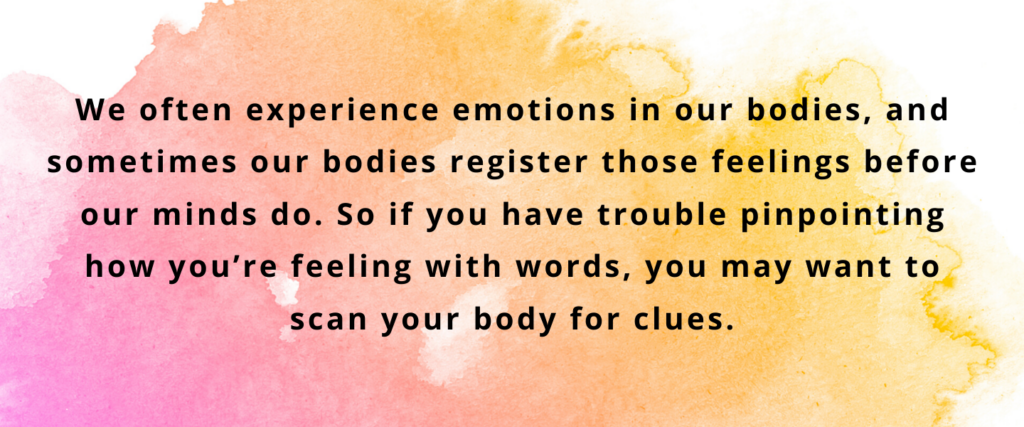
As it happens, we often experience emotions in our bodies, and sometimes our bodies register those feelings before our minds do. So if you have trouble pinpointing how you’re feeling with words, you may want to scan your body for clues. When researchers in Finland performed a series of cross-cultural studies with 701 people from West European and East Asian cultures, they had the participants view various words, stories, movies, or facial expressions, then color specific regions on silhouettes of bodies where they felt activity increasing or decreasing while they viewed each stimulus. This exercise in mapping bodily sensations in response to emotions revealed that basic emotions—including anger, fear, disgust, happiness, sadness, and surprise—were associated with sensations of elevated activity in the upper chest, which likely reflects changes in breathing and heart rate. Increased sensations in the arms and torso were associated with anger. Decreased sensations in the arms and legs corresponded to sadness. And increased sensations in the gut (the digestive system) and throat were found primarily with disgust. The most fascinating revelation was that these effects rang true among people cross-culturally.
So if you have a mental block that makes it difficult to recognize your emotional triggers (which some people do, in a subconscious effort to protect themselves from emotional discomfort), paying attention to your bodily sensations can give you clues about what you’re experiencing. Even if you are highly attuned to your emotional reactions, sometimes they can sneak up on you, and you might experience a particular bodily sensation before you are aware of the actual trigger or your response to it. That’s because we all have blind spots to reflexive emotional states we’re susceptible to experiencing.
This is an excerpt from Emotional Inflammation: Discover Your Triggers and Reclaim Your Equilibrium During Anxious Times by Lise Van Susteren, MD, and Stacey Colino.
Buy your copy of Emotional Inflammation at your favorite bookseller!
Sounds True | Amazon | Barnes & Noble | Bookshop
